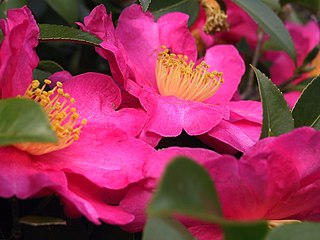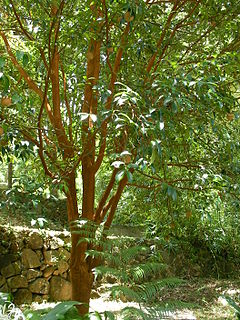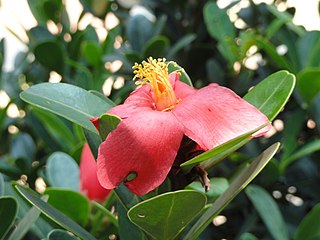
Camellia is a genus of flowering plants in the family Theaceae. They are found in eastern and southern Asia, from the Himalayas east to Japan and Indonesia. There are more than 220 described species, with some controversy over the exact number, and also around 3,000 hybrids. The genus was named by Linnaeus after the Jesuit botanist Georg Joseph Kamel, who worked in the Philippines and described a species of camellia.

Camellia sinensis is a species of evergreen shrub or small tree in the flowering plant family Theaceae. Its leaves and leaf buds are used to produce the popular beverage, tea. Common names include tea plant, tea shrub, and tea tree.

Camellia japonica, known as common camellia, or Japanese camellia, is a species of flowering plant in the family Theaceae. There are thousands of cultivars of C. japonica in cultivation, with many colors and forms of flowers. In the U.S. it is sometimes called japonica. In the wild, it is found in mainland China, Taiwan, southern Korea and southwestern Japan. It grows in forests, at altitudes of around 300–1,100 metres (980–3,600 ft). Camellias are famous throughout East Asia; they are known as tsaa4 faa1 in Cantonese, cháhuā (茶花) in Mandarin Chinese, tsubaki (椿) in Japanese, dongbaek-kkot (동백꽃) in Korean, and as hoa trà or hoa chè in Vietnamese.

Gilbert's potoroo or ngilkat is Australia's most endangered marsupial, the rarest marsupial in the world, and one of the world's rarest critically endangered mammals, found in south-western Western Australia. It is a small nocturnal macropod that lives in small groups.

Camellia hongkongensis, the Hong Kong camellia, is a species of camellia.

Camellia granthamiana, or Grantham's camellia, is a rare, endangered species of Camellia, which was first discovered in Hong Kong in 1955.

Camellia crapnelliana, Crapnell's camellia, is a flowering Camellia native to Hong Kong and other parts of south-eastern China.

Camellia oleifera, which originated in China, is notable as an important source of edible oil obtained from its seeds. It is commonly known as the oil-seed camellia or tea oil camellia, though to a lesser extent other species of camellia are used in oil production too.

Camellia reticulata is a species of flowering plant in the tea family Theaceae, native to southwestern China, in Yunnan and Sichuan Provinces.

Camellia yunnanensis is a 1.3–7 m tall shrub or small tree endemic to China.

Camellia petelotii is a species of plant in the family Theaceae. It is found in China and Vietnam. It may be called the golden camellia and synonyms include C. chrysantha and Camellia nitidissima. The golden camellia originated 170 million years ago, it is a first-class nationally protected plant in China. The golden camellia is extremely demanding on the growth environment, and its genes are extremely difficult to replicate, once transplanted, it will die or genetically mutate. Therefore, in 1986, the Golden Camellia National Nature Reserve was built in Fangcheng, Guangxi, with a total area of 9195.1 hectares.

Camellia euphlebia is a species of plant in the family Theaceae. It is found in China and Vietnam. It is threatened by habitat loss.
Camellia fleuryi is a species of plant in the family Theaceae. It is endemic to Vietnam.

Camellia grijsii is a species of plant in the family Theaceae. It is endemic to China. It is threatened by habitat loss.

Camellia hengchunensis is a species of plant in the family Theaceae. It is endemic to Taiwan.
Camellia pleurocarpa is a species of plant in the family Theaceae. It is endemic to Vietnam.
Camellia pubipetala is a species of plant in the family Theaceae. It is endemic to China. It is threatened by habitat loss.

Pyrenaria buisanensis is a species of tea endemic to Taiwan. It was first described by the Japanese botanist S. Sasaki in 1931, but the herbarium specimens were lost and the species identity remained dubious until a 2004 publication that reported its rediscovery and reclassified it as a species of Pyrenaria. Its status remains controversial, with some sources including in Pyrenaria microcarpa.

Camellia amplexicaulis is a species of flowering tree in the tea family. Originally native to Vietnam, it has been considered extinct in the wild since 2018. It is one of two species of trees in the tea family that only exists in cultivation, the other being Franklinia. It is known in Vietnam as Hải đường.

Camellia azalea, native to the Ehuangzhang Provincial Nature Reserve in Yangchun City, Guangdong, China, is a national first-class protected plant in China. The Chinese name of Camellia azalea is 杜鹃叶山茶/Rhododendron leaf camellia, because of its rhododendron-like leaf shape. Compared with other camellia species, the flower of Camellia azalea is more like Rhododendron, so it is commonly known as 杜鹃红山茶/Rhododendron red camellia. It is also commonly known as 四季紅山茶/Four Seasons Red Camellia or 四季茶花/Four Seasons Camellia, because it can flower throughout the year, July-September is the most prosperous period of flowering, which is different from the habit of Camellia flowering in winter.

















